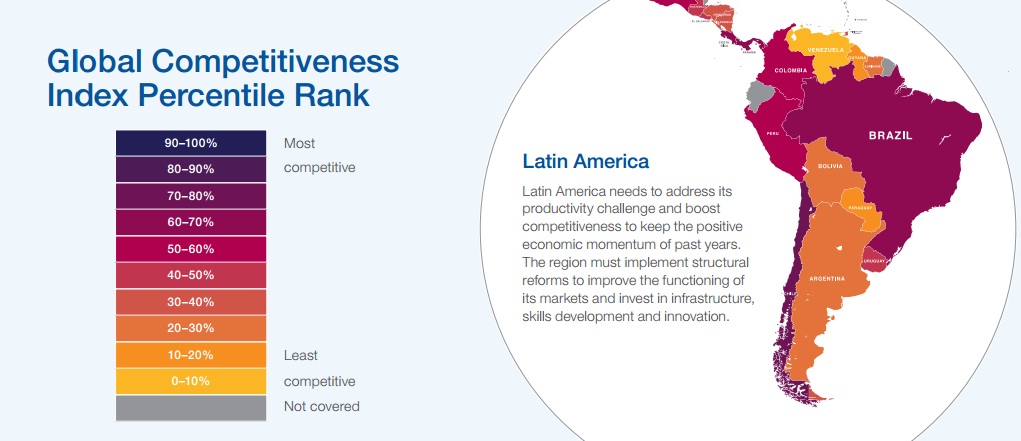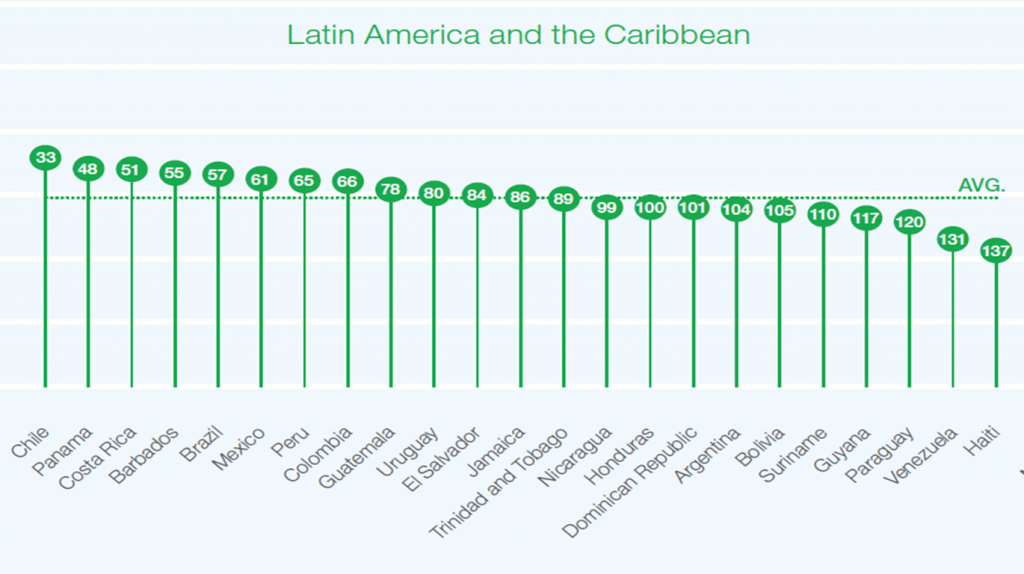World Economic Forum: Only 9 Regional Countries Improved Competitiveness Ranking
Latin America’s economic competitiveness took a dive in 2013. Of the region’s five largest economies, Mexico, Brazil, and Peru each experienced setbacks, while Chile and Colombia demonstrated only slight improvement.The report recommends Latin America initiate immediate structural reforms and productive investments in infrastructure, educational programs, and innovation to reclaim the growth experienced in past decades.
The highest rated country in all of Latin America and the Caribbean was Puerto Rico, which ranked 32 of all countries worldwide, followed by Chile, which sits at 33. The former dropped two spots in the ranking, and the ladder climbed one position when compared with the previous year’s results.
The worst-rated countries in the region were Haiti, at 137, and Venezuela, at 131.
Of the 36 Latin-American and Caribbean countries analyzed, only nine improved their ranking over last year, while two — Nicaragua and Argentina — maintained their positions.
El Salvador made the greatest improvement, jumping 13 positions, while Guyana fell the furthest, dropping 15 spots to 117. The remaining countries all dropped in the rankings, while Ecuador was excluded from the analysis.
The GCI defines competitiveness as “the set of institutions, policies, and factors that determine the level of productivity of a country.” These include the strength of public institutions, innovation, infrastructure, diverse economic environments, and the ability to do business.
Data used in the report was drawn from the World Bank, United Nations, International Monetary Fund, and the World Economic Forum’s Executive Opinion Survey.
Vast Differences in the Carribean
Caribbean countries are characterized by major differences in economic competitiveness. Puerto Rico (32) sits on one side of the spectrum, with extensive state bureaucracy and labor laws, while Haiti (137) sits on the other, suffering from limited access to financing and inferior infrastructure.The most similar countries in the region are Jamaica (86) and Trinidad y Tobago (89), with government bureaucracy, corruption, and crime as their primary areas of concern. Meanwhile, the Dominican Republic (101) is troubled by elevated tax rates and limited access to capital.
Chile at the Top of the Pack
South America also demonstrates similar expansive differences among its countries scores, experiencing a wide array of issues that affect the business climate in the region. Chile (33) ranks the highest, a position that matches the score the country received from the Heritage Foundation Index of Economic Freedom. However, its competitiveness is affected by excessive labor regulations and lack of a skilled workforce.
Corruption and excessive governmental regulation are among the issues afflicting Latin America. (World Economic Forum)
Brazil (57), Peru (65), Colombia (66), and Uruguay (80) comprise the second tier of South American countries. All four share similar obstacles to economic activity, including excessive labor regulations, lack of skilled labor, extensive government regulation, inadequate infrastructure, and corruption.
The report also reflects Argentina’s (104) continued struggles, as a country whose business climate has been affected by tight currency exchange controls and excessive inflation. For their part, Bolivia (105), Suriname (110), and Guyana (117) all suffer from rampant corruption and excessive taxation.
Central America and Mexico: Small Countries with Big Problems
Honduras (100), Mexico (61), Guatemala (78), and Panama (48) report corruption, followed by crime and insecurity, as the greatest obstacles to the development of a fertile business climate.In Nicaragua (99) and Costa Rica (51), state bureaucracy and inefficiency are their greatest impediments. Nicaragua and Panama also share a lack of skilled labor and poor infrastructure as major challenges standing in their way.
The region displays huge gaps between the GCI scores of various countries. Panama and Honduras are separated by 52 countries on the list, while the latter has climbed 11 spots in the rankings over the past year. Only El Salvador (84), and its 13-point jump, improved more than Honduras. No other country in the region showed a significant change in their ranking over the past 12 months.
Switzerland sits atop the global rankings, but could further enhance its competitiveness by improving the skills of its labor force, and limiting government regulation in labor laws. On the complete opposite side of the coin lies Guinea (144), whose lack of access to financing and high rate of government corruption place the country dead last on the WEF list.

No comments:
Post a Comment